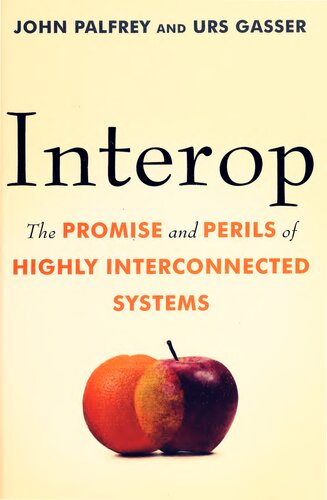

Most ebook files are in PDF format, so you can easily read them using various software such as Foxit Reader or directly on the Google Chrome browser.
Some ebook files are released by publishers in other formats such as .awz, .mobi, .epub, .fb2, etc. You may need to install specific software to read these formats on mobile/PC, such as Calibre.
Please read the tutorial at this link. https://ebooknice.com/page/post?id=faq
We offer FREE conversion to the popular formats you request; however, this may take some time. Therefore, right after payment, please email us, and we will try to provide the service as quickly as possible.
For some exceptional file formats or broken links (if any), please refrain from opening any disputes. Instead, email us first, and we will try to assist within a maximum of 6 hours.
EbookNice Team

Status:
Available4.7
11 reviews(Ebook) Interop The Promise and Perils of Highly Interconnected Systems 1st Edition by John Palfrey, Urs Gasser - Ebook PDF Instant Download/Delivery: 9780465021970 ,0465021972
Full download (Ebook) Interop The Promise and Perils of Highly Interconnected Systems 1st Edition after payment

Product details:
ISBN 10: 0465021972
ISBN 13: 9780465021970
Author: John Palfrey, Urs Gasser
(Ebook) Interop The Promise and Perils of Highly Interconnected Systems 1st Edition Table of contents:
PART I - The Theory of Interop
CHAPTER ONE - The Technology and Data Layers
CHAPTER TWO - The Human and Institutional Layers
PART II - The Promise and Perils of Interop
CHAPTER THREE - Consumer Empowerment
CHAPTER FOUR - Privacy and Security
CHAPTER FIVE - Competition and Uniformity
CHAPTER SIX - Innovation
CHAPTER SEVEN - Systemic Efficiencies
CHAPTER EIGHT - Complexity
PART III - Solving for Interop
CHAPTER NINE - Getting to Interop
CHAPTER TEN - Legal Interop
CHAPTER ELEVEN - Interop by Design: The Case of Health Care IT
CHAPTER TWELVE - Interop over Time: Preservation of Knowledge
CHAPTER THIRTEEN - Architectures of the Future: Building a Better World
CONCLUSION
Acknowledgments
NOTES
SUGGESTED READINGS
INDEX
People also search for (Ebook) Interop The Promise and Perils of Highly Interconnected Systems 1st Edition:
peril and promise latino
on the promise meaning
on the promise of meaning
the promise and peril of things
questions for the cop and the anthem
Tags: John Palfrey, Urs Gasser, Interop, Highly Interconnected Systems, Perils